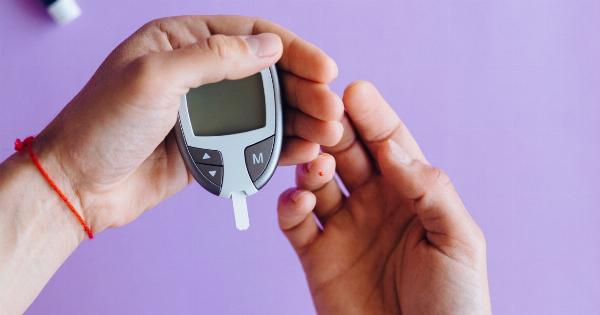Aerobic exercise, also known as cardio exercise, refers to physical activities that increase your heart rate and breathing for an extended period. These exercises are typically rhythmic and use large muscle groups continuously.
Examples of popular aerobic exercises include walking, running, cycling, swimming, and dancing.
Regular physical activity, including aerobic exercise, has numerous health benefits, including weight management, improved cardiovascular health, increased energy levels, and enhanced mental well-being.
For individuals with diabetes, aerobic exercise also has a profound impact on blood sugar levels.
How Does Aerobic Exercise Affect Blood Sugar?
When you engage in aerobic exercise, your muscles require more fuel in the form of glucose for energy. As a result, your body becomes more efficient at metabolizing sugars, leading to improved blood sugar control.
Aerobic exercise helps your body become more insulin sensitive, meaning it is more responsive to the insulin produced by the pancreas, allowing glucose to enter your cells more effectively.
Additionally, aerobic exercise can stimulate the production and release of endorphins, also known as “feel-good” hormones.
These hormones help reduce stress levels and promote a sense of well-being, which can indirectly affect blood sugar control. Stress hormones, such as cortisol, can cause blood sugar levels to rise.
The Benefits of Aerobic Exercise for Diabetes Management
Regular aerobic exercise offers several benefits for managing and controlling diabetes:.
1. Improved Insulin Sensitivity
Aerobic exercise enhances insulin sensitivity, allowing your body to use insulin more efficiently. This effect helps regulate blood sugar levels and decreases the risk of insulin resistance, a hallmark of type 2 diabetes.
Consistent aerobic exercise can even lead to reduced medication requirements for individuals with diabetes.
2. Weight Management
Aerobic exercise helps burn calories, aiding in weight management and preventing obesity. Maintaining a healthy weight is crucial for individuals with diabetes, as excess weight can lead to insulin resistance and uncontrolled blood sugar levels.
Regular aerobic exercise can help achieve and maintain a healthy body weight.
3. Lowered Blood Pressure
Aerobic exercise is known to reduce blood pressure levels, an essential aspect of overall cardiovascular health. High blood pressure is a risk factor for heart disease, which is more prevalent in individuals with diabetes.
By incorporating regular aerobic exercise into your routine, you can help manage your blood pressure and reduce the risk of related complications.
4. Enhanced Cardiovascular Health
Aerobic exercise strengthens the heart and improves cardiovascular fitness.
It helps increase high-density lipoprotein (HDL) cholesterol levels, known as “good” cholesterol, while reducing low-density lipoprotein (LDL) cholesterol levels, known as “bad” cholesterol. This balance promotes heart health and reduces the risk of cardiovascular diseases, which are commonly associated with diabetes.
5. Stress Reduction
The regular practice of aerobic exercise can reduce stress levels and improve mental well-being. Stress can contribute to elevated blood sugar levels in individuals with diabetes.
By engaging in activities that help destress, such as aerobic exercise, you can positively impact your blood sugar control.
Best Practices for Aerobic Exercise
The following best practices can help you incorporate aerobic exercise effectively into your routine:.
1. Consult with Your Healthcare Provider
Before starting any exercise program, especially if you have diabetes, consult with your healthcare provider. They can provide personalized recommendations based on your health status and help you devise an exercise plan that suits your needs.
2. Start Slowly
If you’re new to aerobic exercise, start slowly and gradually increase the intensity and duration. Aim for at least 150 minutes of moderate-intensity aerobic exercise per week or 75 minutes of vigorous-intensity exercise.
Break it down into manageable sessions throughout the week.
3. Monitor Blood Sugar Levels
Keep a close eye on your blood sugar levels before, during, and after exercise. Monitoring your levels helps you understand how different activities affect your blood sugar and allows you to make any necessary adjustments to ensure your safety.
4. Stay Hydrated
Drink plenty of water before, during, and after exercise to stay hydrated. Dehydration can increase the risk of high blood sugar levels and other complications. Carry a water bottle with you during workouts to ensure you have easy access to fluids.
5. Include Warm-up and Cool-down Periods
Always start your aerobic exercise routine with a warm-up period to prepare your body for physical activity. Likewise, conclude your workout with a cool-down period to gradually reduce your heart rate.
Both warm-up and cool-down periods help prevent injuries and minimize post-exercise dizziness or lightheadedness.
Precautions for Aerobic Exercise with Diabetes
While aerobic exercise is generally safe and beneficial for individuals with diabetes, certain precautions should be taken:.
1. Carry Identification
Always carry identification, such as a medical alert bracelet or a card indicating that you have diabetes. In the event of an emergency, this ensures that healthcare professionals are aware of your condition and can provide appropriate care.
2. Be Aware of Hypoglycemia
Hypoglycemia, or low blood sugar, can occur during or after exercise, especially if you take certain diabetes medications.
Be familiar with the signs and symptoms of hypoglycemia and carry a source of fast-acting carbohydrates, such as glucose tablets or fruit juice, to treat it if needed.
3. Wear Proper Footwear
Choose comfortable, supportive footwear that fits properly to minimize the risk of foot injuries or blisters. Individuals with diabetes may have reduced sensation in their feet, making them more prone to foot problems.
Proper footwear can help protect your feet during aerobic exercise.
4. Monitor for High Blood Sugar
In some cases, strenuous or prolonged aerobic exercise can temporarily raise blood sugar levels. Regularly monitor your blood sugar and consult with your healthcare provider about any necessary adjustments to your medication or insulin doses.
5. Modify Exercise Intensity as Needed
If you experience any exercise-related symptoms such as dizziness or chest pain, stop exercising and seek medical attention. Modify your exercise intensity, duration, or type if advised by your healthcare provider.
Incorporating Aerobic Exercise into Your Routine
To make aerobic exercise a regular part of your routine, consider the following tips:.
1. Choose Activities You Enjoy
Engage in activities that you find enjoyable and interesting. This increases the likelihood that you will stick to your exercise routine in the long term.
Experiment with different aerobic exercises until you find the ones that bring you the most satisfaction.
2. Find an Exercise Buddy
Exercising with a friend or family member can make your workouts more enjoyable and help keep you motivated and accountable. Choose someone who shares your fitness goals and understands the importance of regular exercise.
3. Set Realistic Goals
Set achievable goals for yourself and track your progress. Start with small milestones and gradually increase the intensity or duration of your workouts. Celebrate your accomplishments along the way to stay motivated.
4. Mix Up Your Routine
Avoid monotony by incorporating a variety of aerobic exercises into your routine. This not only keeps your workouts interesting but also helps target different muscle groups and prevents overuse injuries.
Try new activities or classes to keep your exercise routine fresh.
5. Schedule Regular Exercise Time
Make aerobic exercise a priority by scheduling it into your daily or weekly routine. Treat it as an important appointment that you cannot miss. Consistency is key to reaping the benefits of regular aerobic exercise.
Conclusion
Aerobic exercise plays a vital role in managing and controlling blood sugar levels in individuals with diabetes.
By incorporating regular aerobic exercise into your routine, you can improve insulin sensitivity, aid in weight management, reduce blood pressure, enhance cardiovascular health, and promote stress reduction. However, it’s important to consult with your healthcare provider and take necessary precautions to ensure your safety during exercise.
With proper guidance and consistent effort, aerobic exercise can become an enjoyable and effective tool in your diabetes management toolbox.































